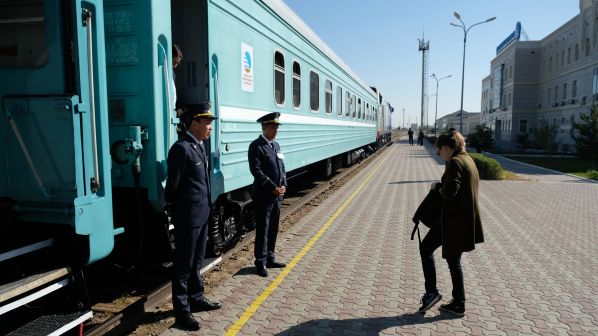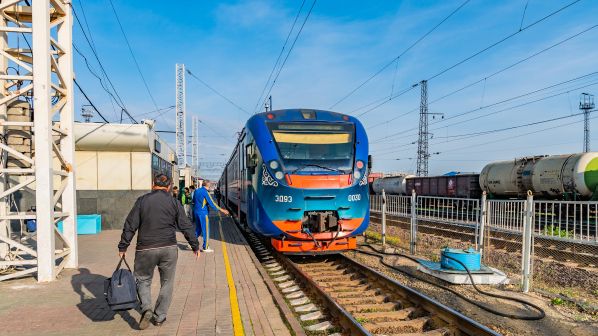MOVING across Kazakhstan, the world’s largest landlocked country, is no easy task. Travelling from the capital Nur-Sultan to Almaty, the country’s largest metropolis, is a 1334km journey by rail. Travelling from Nur-Sultan in the east to Atyrau in the west, on the shores of the Caspian Sea, is a 1500km journey as the crow flies, or a 2300km journey by rail.
Such distances put people off driving, while there is still a willingness to take long train journeys rather than fly.
In light of this, Kazakhstan Railways’ (KTZ) passenger subsidiary commands a strong position with a 40% share of the passenger transport market. Most services run from city to city, with sleeper trains playing an important role as journey times can stretch to more than 50 hours.
But the dynamics behind KTZ’s strong position are beginning to change. As the economy in Kazakhstan improves and the Kazak people become better off financially, they are expected to embrace faster modes of transport such as flying.
“We expect that we will lose traffic to the airlines in the long run,” says Mr Peter Sturm, who was appointed as CEO of KTZ Passenger in July 2020 after previously working at German Rail (DB), including as executive director, Asia-Pacific of DB Engineering and Consulting.
In response to this change in travel habits, KTZ Passenger is adapting its travel offer with a new strategy developed towards the end of last year: instead of trying to compete head-on with other modes of transport, KTZ is looking to connect with them to create an intermodal transport system.
“We are talking to airlines, bus operators and taxi companies, and with [Russian Uber alternative] Yandex, to finally set up a complete intermodal transport system,” Sturm says. “We hope that we can synchronise timetables and then reduce travel times for the people of Kazakhstan. We could provide a much better service when we combine all these different modes of transport.”
“We think that we can stop the declining demand for rail transport in the long run, by providing more services from the hubs to the rural areas.”
Peter Sturm, CEO of KTZ's passenger subsidary
The core of this system is a network of city hubs connected by air and rail to provide passengers with a choice of mode. Interurban shuttle services will connect airports, railway stations and bus terminals. From these hubs, rail services would radiate out to rural areas where 50% of the Kazakhstan population lives.“We think that we can stop the declining demand for rail transport in the long run, by providing more services from the hubs to the rural areas,” Sturm says.
The first pilot projects are expected to be introduced together with cities’ public transport operators and airlines by the end of 2021.
This network will be connected through a digital ticketing system, allowing passengers to book a multi-modal trip covering all legs of a journey with a single fare.

KTZ Passenger has already begun to move towards the new system, introducing digital ticketing in 2019. This has proved popular, with 55% of all tickets sold online in 2020, although this may have been affected by the Covid-19 pandemic.
KTZ is now looking to integrate other operators’ fares into its offering, with the first pilot project for the ticketing system due to be launched in the second half of 2021. The operator is also in discussions with airlines, including international carriers, to provide a combined offer that would allow passengers to fly into one of Kazakhstan’s main airports and catch a train to cities with a population of more than 500,000 residents where there is no airport.
KTZ’s trains currently have a utilisation rate of between 60 to 70%. While this may be on par with other rail operators, Sturm says it is still below the average rate for airlines. “Therefore, we are going to set up a loyalty programme for our customers offering certain discount rates, which is going to be introduced this year,” he says.
Starting from the summer holiday period, KTZ will promote its offer and attract more passengers by advertising the changes and service improvements that have already been made over the past two years. This includes improved onboard cleaning, new linen in sleeping cars, higher frequency services, and renovated toilets, including the installation of new bio-toilets.
This work is already having an effect, as KTZ’s passenger satisfaction surveys demonstrate. Last year, passengers rated KTZ’s service 4.6 out of 5. “This is quite satisfactory for us because two years ago, everybody said our service level was quite low,” Sturm says. “We can see the customers recognise that we have changed a lot and improved a lot.”
While passenger numbers were dropping slightly before the Covid-19 pandemic, the resulting shutdowns had a significant impact on numbers, which halved in 2020. KTZ carried 8.1 million passengers in 2020, compared with 16.2 million in 2019 and 17.5 million in 2018. The biggest drop was from April to December, when passenger numbers fell to 4.6 million, compared with 12.2 million during the same period in 2019, and 13.5 million in 2018. KTZ is predicting a slight recovery in 2021, to 10.9 million passengers for the year if international trains remain suspended, and 13.4 million if international services resume.
Fleet renewal
The new operational approach is also requiring KTZ to adapt its fleet strategy to meet new demands.
While ageing trains make up a large proportion of the KTZ fleet, the operator has purchased a fleet of 670 coaches forming 25 trains from Talgo over the past decade, under a joint venture with the Tulpar Wagon Building Plant on the outskirts of Nur-Sultan. A final set of 62 coaches is due to be delivered in the near future.
With this joint venture coming to an end, KTZ has launched a tender to sell the plant, with the winning bidder expected to supply and maintain a new fleet of overnight trains. The competition is being facilitated by DB Engineering and Consulting under a cooperation launched in autumn 2019.
“We want to force competition in the market and also to allow medium-sized maintenance enterprises to get contracts.”
Peter Sturm
Stadler, Switzerland, and Transmashholding (TMH) subsidiary Tver Carriage Works (TVZ), Russia, have been shortlisted for the contract.
TVZ has already supplied 52 coaches to KTZ, while the operator ordered a 10-car Type ED9E EMU from TMH’s Demikhovsky Engineering Plant in May.
KTZ is expected to sign a strategic agreement with the winning bidder, covering the investment in and purchase of the Tulpar site later this year. Under the control and support of the strategic partner, Tulpar Wagon Building Plant will then sign an agreement to supply coaches to KTZ between 2022 and 2029. This includes a minimum of 26 trains consisting of around 18 coaches each, including a mix of:
- sleeper compartment coaches
- sleeper compartment coaches with compartments for staff and passengers with reduced mobility
- open-plan semi-sleeper cars
- saloon coaches with reclining seats, and
- generator cars.
“These are quite modern trains based on international standards, and will provide our customers with a completely new level of comfort,” Sturm says.
The service aspect of the contract includes providing technical support, maintenance, repairs, spare parts, overhauls and obsolescence management for 20 years, with the possibility of an option for another 20 years.

recover slightly in 2021, especially if international trains are able to resume.
Photo: Shutterstock/Vladimir Tretyakov
“For the Talgo trains, we outsource maintenance to Talgo, and we get quite a high level of maintenance service,” Sturm says. “For the new fleet, we are discussing whether the manufacturer should do the maintenance, and this is one option we have in the tender.”
KTZ is also reimagining how it procures its wider fleet maintenance, which was previously carried out by KTZ’s subsidiary Wagon Services, which has around 3000 employees. Wagon Services will continue to carry out line maintenance and additional services throughout its network which gives a distribution all over Kazakhstan.
Tendering
However, in order to introduce competition to the market and attract interest from medium sized companies, KTZ has begun tendering heavy maintenance and overhaul, which attracted bids from eight companies.
“We want to force competition in the market and also to allow medium-sized maintenance enterprises to get contracts,” he says. “We changed the whole environment and tender conditions and attracted many more companies to bid for our maintenance projects.”
Sturm is also overseeing the introduction of a quality management system, including the implementation of an app that allows staff to log faults and defects. A pilot project was successfully launched in December, with the system due to be introduced from July.
“It’s a big step forward because in the past, we didn’t have statistics about the defects and deficiencies,” Sturm says. “Now we can see what the deficiencies are, what failures there are, and so on, and then we can analyse and start to rectify all those deficiencies. And then we come into a systematic working approach.”
In order to streamline fleet management, KTZ has created a fleet management system with teams dedicated to each fleet. “They are covering all aspects of the fleet,” Sturm says. “They do the technical analysis, the quality management, they make the specifications for spare parts - everything is done within one team and there’s a clear overview. I expect a huge improvement in quality and cost savings from this measure.”
KTZ is focusing on developing local partners for maintenance as it eyes its future strategy, but Sturm says they are also looking to work with international companies as it implements its wider strategy. The introduction of shorter regional services will also potentially require the purchase of new fleets of DMUs or EMUs, which are currently being explored.
The overall strategy will run to 2039, although some measures such as the introduction of the multi-modal system are expected to be implemented within the next four to five years, heralding the dawn of a new era for KTZ’s passenger operation.

